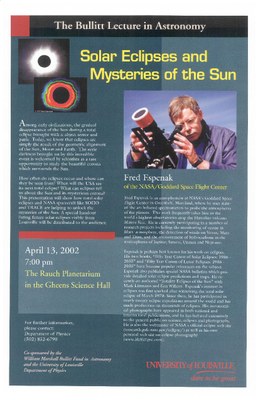Bullitt Lecture in Astronomy 2002 - Solar Eclipses and Mysteries of the Sun
| When |
Apr 13, 2002
from 07:00 PM to 08:00 PM |
|---|---|
| Where | Gheens Science Hall & Rauch Planetarium |
| Add event to calendar |
|
Speaker: Fred Espenak, NASA/Goddard Space Flight Center
 Abstract: Among early civilizations, the gradual disappearance of the Sun during a total eclipse brought with it abject terror and panic. Today we know that eclipses are simply the result of a geometric alignment of the Sun, Moon, and Earth. The eerie darkness brought on by this incredible event is welcomed by scientists as a rare opportunity to study the beautiful corona which surrounds the Sun. How often do eclipses occur and where can they be seen from? When will the USA see its next total eclipse? What can eclipses tell us about the Sun and its mysterious corona? This presentation will show how total solar eclipses and NASA spacecraft like SOHO and TRACE are helping to unlock the mysteries of the Sun. A special handout listing future solar eclipses visible from Louisville will be distributed to the audience.
Abstract: Among early civilizations, the gradual disappearance of the Sun during a total eclipse brought with it abject terror and panic. Today we know that eclipses are simply the result of a geometric alignment of the Sun, Moon, and Earth. The eerie darkness brought on by this incredible event is welcomed by scientists as a rare opportunity to study the beautiful corona which surrounds the Sun. How often do eclipses occur and where can they be seen from? When will the USA see its next total eclipse? What can eclipses tell us about the Sun and its mysterious corona? This presentation will show how total solar eclipses and NASA spacecraft like SOHO and TRACE are helping to unlock the mysteries of the Sun. A special handout listing future solar eclipses visible from Louisville will be distributed to the audience.
Fred Espenak is an astrophysicist at NASA's Goddard Space Flight Center in Greenbelt, Maryland, where he uses state-of-the art infrared spectrometers to probe the atmospheres of the planets. This work frequently takes him to the worlds highest observatories atop the Hawaiian volcano Mauna Kea. He is currently participating in a number of research projects including the monitoring of ozone in in Mars' atmosphere, the detection of winds on Venus, Mars and Titan, and the measurement of hydrocarbons in the stratosphere of Jupiter, Saturn, Uranus and Neptune. Espanek is perhaps best know for his work on eclipses. His two books, "Fifty Year Canon of Solar Eclipses: 1986 - 2035" and "Fifty Year Canon of Lunar Eclipses: 1986 - 2035" have become popular references on the subject. Espanek also publishes special NASA bulletins which provide detailed solar eclipse predictions and maps. He recently co-authored "Totality Eclipses of the Sun" with Mark Littmann and Ken Willcox. Espenak's interest in eclipses was first sparked after witnessing the total solar eclipse of March 1970. Since the, he hasparticipated in nearly twenty eclipse expeditions around the world and has made predictions on thousands of eclipses. His astronomical photographs have appeared in both national and international publications, and he has lectured extensively to the general public on science, eclipses and photography. He is also the webmaster of NASA's official eclipse web site (sunearth.gsfc.nasa.gov/eclipse/) as well as his own personal web site on eclipse photography (www.mreclipse.com).
